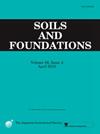Slaking mechanisms of a mudstone and prediction of its number-size distribution considering shape evolution
IF 3.3
2区 工程技术
Q2 ENGINEERING, GEOLOGICAL
引用次数: 0
Abstract
The wide distribution of mudstone poses challenges to efficient construction and safe long-term maintenance of infrastructure, primarily due to its susceptibility to slaking. To explore the slaking mechanisms, cyclic wetting–drying slaking tests under both atmospheric and vacuum conditions were conducted on natural mudstone collected from Akita Prefecture, Japan. A multi-view approach was employed to capture the evolution of three-dimensional particle shape, enabling quantitative analysis of slaking mechanisms and the development of number-size and surface area-size distribution models that account for shape effects. The results indicate that the atmospheric slaking proceeds more rapidly than vacuum slaking tests, attributed to the elimination of the air-breakage phenomenon. Shape evolution analysis reveals that the shell-like medium-sized particles possess higher specific surface areas, resulting from the typical layered slaking phenomenon observed during slaking. These layered fragments are attributed to differential swelling, driven by non-uniform moisture distribution in the specimens. The contribution of this mechanism is validated and quantitatively assessed through a comparative analysis of particle shape compositions across different slaking conditions. Finally, particle shape evolution is integrated into predictive models for number-size and surface area-size distributions. The performance of these models is verified against experimental measurements.
考虑形态演化的泥岩溶蚀机理及数粒分布预测
泥岩的广泛分布给基础设施的高效建设和长期安全维护带来了挑战,主要是由于泥岩易滑脱。为探索泥岩的熟化机理,在常压和真空条件下对日本秋田县天然泥岩进行了干湿循环熟化试验。采用多视角方法捕捉三维颗粒形状的演变,实现了对松弛机制的定量分析,并建立了考虑形状效应的数量-尺寸和表面积-尺寸分布模型。结果表明,由于消除了空气破碎现象,常压熟化试验比真空熟化试验进行得更快。形状演化分析表明,壳状中等颗粒具有较高的比表面积,这是由于在熟化过程中观察到典型的分层熟化现象所致。这些层状碎片是由于试样中水分分布不均匀造成的差异膨胀。这一机制的贡献是验证和定量评估,通过比较分析颗粒形状组成在不同的软化条件。最后,将颗粒形状演变整合到数量-尺寸和表面积-尺寸分布的预测模型中。通过实验验证了这些模型的性能。
本文章由计算机程序翻译,如有差异,请以英文原文为准。
求助全文
约1分钟内获得全文
求助全文
来源期刊

Soils and Foundations
工程技术-地球科学综合
CiteScore
6.40
自引率
8.10%
发文量
99
审稿时长
5 months
期刊介绍:
Soils and Foundations is one of the leading journals in the field of soil mechanics and geotechnical engineering. It is the official journal of the Japanese Geotechnical Society (JGS)., The journal publishes a variety of original research paper, technical reports, technical notes, as well as the state-of-the-art reports upon invitation by the Editor, in the fields of soil and rock mechanics, geotechnical engineering, and environmental geotechnics. Since the publication of Volume 1, No.1 issue in June 1960, Soils and Foundations will celebrate the 60th anniversary in the year of 2020.
Soils and Foundations welcomes theoretical as well as practical work associated with the aforementioned field(s). Case studies that describe the original and interdisciplinary work applicable to geotechnical engineering are particularly encouraged. Discussions to each of the published articles are also welcomed in order to provide an avenue in which opinions of peers may be fed back or exchanged. In providing latest expertise on a specific topic, one issue out of six per year on average was allocated to include selected papers from the International Symposia which were held in Japan as well as overseas.
 求助内容:
求助内容: 应助结果提醒方式:
应助结果提醒方式:


